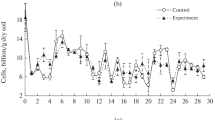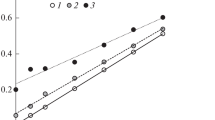Abstract
Among soil microorganisms, bacteria are particularly suitable for quantification by counting. It should be considered, however, that bacteria are never uniformly distributed in the soil and that their spatial arrangement varies even in neighbouring microsites. Furthermore, the bacterial biomass may fluctuate drastically within short periods. Counting of soil bacteria can be achieved by direct microscopy as well as by cultural methods. The most widespread cultural method, the plate count technique, is based on the development of colonies from individual propagules. Microscopic bacteria counts of soil samples are often up to 1000 times greater than viable counts obtained by cultural techniques. The reasons for the greater values obtained by microscopy are the inclusion of dead cells and organisms which fail to grow in conventional culture media under the conditions of incubation provided. Groups of bacteria generally not included in viable counts are e.g. nitrogen-fixing bacteria, nitrifiers, cellulolytic organisms and anaerobic bacteria, as they depend on selective media and/or special growth conditions.
Access this chapter
Tax calculation will be finalised at checkout
Purchases are for personal use only
Preview
Unable to display preview. Download preview PDF.
Similar content being viewed by others
References
Arredondo R, Jerez C (1989) Specific dot-immunobinding assay for the detection and enumeration of Thiobacillus ferroxidans. Appl Environ Microbiol 31:524– 528
Bohlool BB, Schmidt EL (1980) The immunofluorescence approach in microbial ecology. In:Alexander M (ed) Advances in microbial ecology 4. Academic Press, London, pp 203–241
Dunger W, Fiedler HJ (1989) Methoden der Bodenbiologie. Gustav Fischer Verlag, Stuttgart
Galfre G, Milstein C (1981) Preparation of monoclonal antibodies:strategies and procedures. Meth Knzymol 73:3–46
Levanony II, Bashan Y (1990) Avidin-biotin complex incorporation into enzyme linked immunosorbent assay (ABELISA) for improving the detection of Azospirillum brasi1ensecd. Curr Microbiol 20:91–94
Ogan M (1991) Studies on the ecology of aquatic bacteria of the lower Niger delta:populations of viable cells and physiological groups. Arch Hydrobiol 124:235–252
Page AL, Miller RII, Keenev DR (eds) (1982) Methods of soil analysis, part 2. Am Soc Argon, Madison, Wisconsin
Schloter M, Bode W, Hartmann A, Beese F (1992) Sensitive chemoluminescence based quantification of bacteria in soil extracts with monoclonal antibodies. Soil Biol Biochem 24:399–403
Schloter M, Borlinghaus R, Bode W, Hartmann A (1993) Direct identification and localization of Azospirillumin the rhizosphere of wheat using fluorescence- labeled monoclonal antibodies and confocal scanning microscopy. J Microsc 171:173–177
Schloter M, Moens S, Groes G, Reidel G, Esquenet M, De Mot R, Hartmann A, Michiels K (1994) Characterization of cell surface components of Azospirillum brasilenseSp7 as antigenic determinants for strain-specific monoclonal antibodies. Microbiology 140:823–828
Trolldenier G (1973) The use of fluorescence microscopy for counting soil microorganisms. Bull Ecol Res Committee, Stockholm, 17:53–59
Clarholm M, Rosswall T (1979) Biomass and turnover of bacteria in a forest soil and a peat. Soil Biol Biochem 12:49–57
Lehner A, Nowak W, Seibold L (1958) Eine Weiterentwicklung des Boden- Fluorochromierungs verfahrens mit Acridinorange zur Kombinationsmethode. Landw Forsch 11:121–127
Schmidt EL, Paul EA (1982) Microscopic methods for soil microorganisms. In:Page AL, Miller RH, Keeney DR (eds) Methods of soil analysis, part 2. Am Soc Agron, Madison Wisconsin, pp 803–814
Strugger S (1949) Fluoreszenzmikroskopie und Mikrobiologie. Schaper-Verlag, Hannover
Trolldenier G (1965) Fluorescenzmikroskopische Untersuchung der Rhizosphäre. Landw Forsch 19, Sonderheft:110–115
Trolldenier G (1972) Fluoreszenzmikroskopische Zählung von Bodenbakterien. I. Historischer Überblick und Beschreibung eines Verfahrens zur Zahlung von Bodenbakterien in Trockenpraparaten nach Farbung mit Acridinorange. Zentralbl Bakt II, 127:25–40
Trolldenier G (1973) The use of fluorescence microscopy for counting soil microorganisms. Bull Ecol Res Committee, Stockholm, 17:53–59
Trolldenier G, Schäfer P (1972) Fluoreszenzmikroskopische Zählung von Bodenbakterien. II. Historischer Überblick und Bechreibung eines Verfahren zur Zählung von Bodenbakterien in Trockenpräparaten nach Färbung mit Acridinorange. Zentralbl Bakt II, 127:41–50
Hirsch CF, Christensen DL, (1983) Novel method on selective isolation of actionomytes. Applied Environ Microbiol 46:925–929
Trolldenier G (1966) Über die Einung Erde enthaltender Nährsubstrate zur Zählung und Isolierung von Bodenmikroorganismen auf Membrabfiltern. Zentralbl BaktII, 20:496–508
Trolldenier G (1967) Isolierung und Zählung von Bodenactinomyceten auf Erdplatten mit Membranfiltren. Pant Soil 27:285–288
Trolldenier G (1971) Einfluß der Kalium- und Stickstoffernaährung von Weinzen auf die Bakterirnbesiedlung der Rhizophäre. Landw Forsch 26/II, Sonderheft:37–46
Wollum II AG (1982) Cultural methods for soil microorganism. In:Page AL, Miller RH, Keeney DR (eds) Methods of soil analysis, part 2. Am Soc Argon, Madison, Wisconsin, pp 781–802
Alexander M (1982) Most probable number method for microbial populations. In:Page AL, Miller RH, Keeney DR (eds) Methods of soil analysis, part 2. Am Soc Argon, Madison, Wisconsin, pp 815–820
Dunger W, Fiedler HJ (1989) Methoden der Bodenbiologie. Gustav Fischer Verlag, Stuttgart
Benckiser G, Syring K-M (1992) Denitrifikation in Agrarstandorten. BioEngineering 8:46–52
Rheinbaben von W (1990) Nitrogen losses from agricultural soils through devitrification — a critical evaluation. Z Pflanzenernaehr Bodenkd 153:157–166
Tiedje JM (1982) Denitrification. In:Page AL, Miller RH, Keeney DR (eds) Methods of soil analysis, part 2. Am Soc Agron, Madison, Wisconsin, pp 1011–1026
Keeney DR, Nelson DW (1982) Nitrogen — inorganic forms. In:Page AL, Miller RH, Keeney DR (eds) Methods of soil analysis, part 2. Am Soc Agron, Madison, Wisconsin, pp 645–698
Molina JAE, Rovira AD (1964) The influence of plant roots on autotrophic nitrifying bacteria. Can J Microbiol 10:249–257
Schmidt EL (1982) Nitrification in soils. In:Stevenson FJ (ed) Nitrogen in agricultural soils. Am Soc Agron, Madison, Wisconsin, pp 253–288
Schmidt EL, Belser LW (1982) Nitrifying bacteria. In:Page AL, Miller RH, Keeney DR (eds) Methods of soil analysis, part 2. Am Soc Agron, Madison, Wisconsin, pp 1027–1042
Brown ME, Burlingham SK, Jackson RM (1962) Studies on Azotobacterspecies in soil. I. Comparison of media and techniques for counting Azotobacterin soil. Plant Soil 17:309–319
Döbereiner J, Day JM (1974) Associative symbioses on tropical grasses:characterization of microorganisms and dinitrogen-fixing sites. In:Newman WE, Nyman CJ (eds) Proceedings 1st international symposium on nitrogen fixation, vol 2. Washington State University Press, Pullman, pp 518–538
Knowles R (1982) Free-living dinitrogen-fixing bacteria. In:Page AL, Miller RH, Keeney DR (eds) Methods of soil analysis, part 2. Am Soc Agron, Madison, Wisconsin, pp 1071–1092 Rennie RJ (1981) A single medium for the isolation of acetylene-reducing (dinitrogen-fixing) bacteria from soils. Can J Microbiol 27:8–14
Rennie RJ (1981) A single medium for the isolation of acetylene-reducing (dinitrogen-fixing) bacteria from the soil. Can J Microbiol 27:8–14
Trolldenier G (1977) Influence of some environmental factors on nitrogen fixation in the rhizosphere of rice. Plant Soil 47:203–217
Watanabe I, Barraquio WL, De Guzman MR, Cabrera DA (1979) Nitrogen-fixing (acetylene reduction) activity and population of aerobic heterotrophic nitrogen- fixing bacteria associated with wetland rice. Appl Environ Microbiol 37:813– 819
Galfre G, Milstein C (1981) Preparation of monoclonal antibodies:Strategies and procedures. Meth Enzymol 73:3–46
Harlow E, Lane D (1988) Antibodies:a laboratory manual. Cold Spring Harbor Labratory, Cold Spring Harbor, New York
Levanony H, Bashan Y (1990) Avidin-biotin complex incorporation into enzyme linked immunosorbent assay (ABELISA) for improving the detection of Azospirillum brasilense cd. Curr Microbiol 20:91–94
Schloter M, Bode W, Hartmann A, Beese F (1992) Sensitive chemoluminescence based quantification of bacteria in soil extracts with monoclonal antibodies. Soil Biol Biochem 24:399–403
Schloter M, Assmus B, Hartmann A (1995) The use of immunological methods to detect and identify bacteria in the environment. Biotec Adv 13:75–90
Editor information
Editors and Affiliations
Rights and permissions
Copyright information
© 1996 Springer-Verlag Berlin Heidelberg
About this chapter
Cite this chapter
Trolldenier, G., Schholter, M., Bode, W., Hartmann, A. (1996). Bacterial Biomass. In: Schinner, F., Öhlinger, R., Kandeler, E., Margesin, R. (eds) Methods in Soil Biology. Springer, Berlin, Heidelberg. https://doi.org/10.1007/978-3-642-60966-4_3
Download citation
DOI: https://doi.org/10.1007/978-3-642-60966-4_3
Publisher Name: Springer, Berlin, Heidelberg
Print ISBN: 978-3-642-64633-1
Online ISBN: 978-3-642-60966-4
eBook Packages: Springer Book Archive




